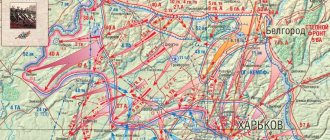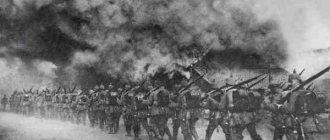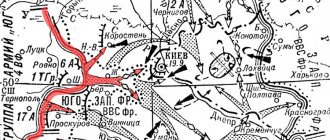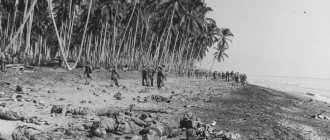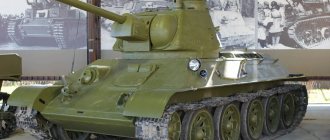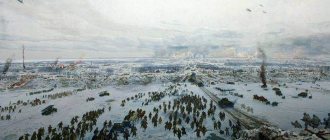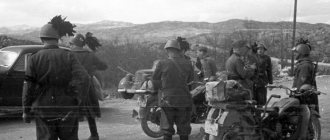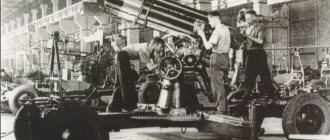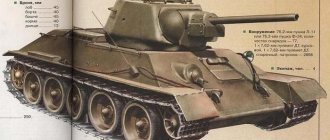07/12/43 – beginning of the Oryol operation “Kutuzov”
The Oryol strategic offensive operation "Kutuzov" was carried out from July 12 to August 18, 1943 during the Battle of Kursk with the goal of the final defeat of the enemy group near Orel. According to the operation plan, on July 12, troops of the Western and Bryansk fronts launched an offensive in the Oryol direction. On July 15, in order to reach the lines occupied before the German offensive, the Central Front launched a counteroffensive, and by the end of July 18, it had completely restored its previous position. On the morning of July 19, the troops of the Central Front launched a strategic offensive in the Kursk-Krom direction, fully participating in Operation Kutuzov.
The enemy forces on the Oryol bridgehead amounted to up to 37 divisions (including 8 tank and two motorized divisions, as part of the 9th Army and 2nd Tank Army). The main defense line of the German troops was equipped to a depth of 5-7 km, the enemy turned large settlements into strong strongholds. The cities of Orel, Bolkhov, Mtsensk and Karachev were especially well prepared for all-round defense. German troops numbered over 600 thousand personnel. They were armed with 7 thousand guns and mortars, 1,200 tanks and self-propelled guns, and over 1,000 aircraft.
The advancing forces of the three fronts were twice as large as the enemy troops in manpower alone and had 1,280 thousand personnel. In terms of armament, the superiority of the Red Army reached 2-3 times superiority: 21 thousand guns and mortars, 2.4 thousand tanks and self-propelled guns and over 3 thousand aircraft.
Map diagram of the Oryol offensive operation.
In the first two days of the offensive, troops of the Western and Bryansk fronts broke through the enemy’s tactical defense zone on the Oryol-Kursk Bulge. The offensive unfolded in a wide zone, which allowed the Central Front to strike in the direction of Krom. On July 29, Bolkhov was liberated, and by the morning of August 5, Oryol was liberated. On August 15, Soviet troops liberated Karachev and by August 18 approached the enemy’s defensive line “Hagen” east of Bryansk. This ended the Soviet offensive. With the defeat of Army Group Center near Orel, the plans of the German command to use the Oryol bridgehead for an attack in an eastern direction collapsed. The counteroffensive began to develop into a general offensive of the Red Army to the west.
German troops on the defensive.
Soviet troops are on the offensive.
Soviet tanks in Orel.
The first fireworks during the war were given in honor of the liberation of Orel and Belgorod on the evening of August 5, 1943 in Moscow. The defenders of the Kursk Bulge were saluted that day by 24 artillery brigades, who placed salute guns on various streets and vacant lots of Moscow so that the salvos were visible from everywhere. A total of 10-15 salvos were fired from each.
As a result of the operation, the Red Army lost 112 thousand killed, 317 thousand wounded, 2,586 tanks and self-propelled guns, 892 guns and mortars, 1,014 combat aircraft. German losses amounted to 40 thousand people. The successful completion of the operation, albeit with colossal losses, created the conditions for an offensive in the Bryansk direction and the entry of Soviet troops into the eastern regions of Belarus.
See also: Photo |
THE USSR. Eagle during the war Share in:
How Orel was liberated
Author: A. A. Vorobyov, chief specialist of the department for the use of documents of the OSU SAOO
1943 became for the residents of Orel and the Oryol region the year of complete liberation from Hitler's tyranny. There were fierce battles in the Oryol direction.
They deployed in the summer of 1943. The fascist command attached great strategic importance to Orel. Hitler's generals considered the city as a springboard for an attack on Moscow and at the same time as a bastion of German defense on the central sector of the front. During the 22 months of occupation of the city, the enemy turned the Oryol bridgehead into a powerful fortified area and created deeply echeloned long-term structures based on numerous water lines. The press and radio of the occupiers declared the Eagle a symbol of the inviolability of German defense.
On the morning of July 5, large forces of tanks and infantry, supported by aviation, went on the offensive in the Oryol-Kursk and Belgorod directions. The offensive began in accordance with an order issued by Hitler the day before, which announced that “the German army is proceeding to a general offensive on the Eastern Front.”
However, Hitler's plans did not come true. When it became known that the enemy was preparing to attack, our troops launched a preemptive artillery strike on enemy positions. Having suffered heavy losses, Hitler's army nevertheless went on the offensive, during which it suffered significant damage in tanks, guns, aircraft and human resources, without achieving success. In unsuccessful attempts to capture the Kursk bridgehead and thereby prepare the conditions for an offensive from the Oryol bridgehead to Moscow, the enemy lost 2,900 tanks, 1,039 guns, 1,392 aircraft, over 5,000 vehicles and more than 70 thousand soldiers and officers during the period from July 5 to 23.
Soviet troops not only thwarted the German summer offensive, but on July 12, 1943, they themselves launched a decisive offensive in the general direction of Orel. Fulfilling the order of the Supreme High Command, the Red Army troops, despite heavy rains and impassable roads, overcame enemy resistance, steadily moving forward.
On August 4, our troops captured Oryol in a semicircle from the north and northeast and began a general attack on the city. A tank group consisting of the 17th Guards Tank Brigade of the 34th Separate Tank Regiment of the 1st Guards Tank Corps and the 380th Rifle Division were advancing from the northeast. Tankers broke into the streets of the city - Pushkinskaya and Moskovskaya. On one of the buildings on the street. Pushkin soldiers hoisted a red flag (only the name of the sergeant is known - Nikolai Fedorovich Malashenko). At 4:40 a.m. on August 5, the 129th Rifle Division with its main forces entered the city. At 2 a.m. on August 5, soldiers of the 1262nd Infantry Regiment of this division, Sergeants V.I. Obraztsov and I.D. Sanko hoisted a red flag at house number 11 on the street. Moskovskaya, now Mira Square, 5 (on August 16, 1943, the flag was removed and transferred for eternal storage to the Artillery Museum of the Red Army).
By 4 p.m., the entire Oryol, from the outskirts to the center, was liberated from the Nazis. Units of the 380th Infantry Division entered the city from the east, and units of the 5th and 129th Infantry Divisions entered the city from the southeast and south. Six banners of Victory floated above the Eagle.
In the fierce battles for Orel, Soviet troops did not do without serious material and human losses. On August 3, on the approaches to Orel, near the village of Nizhnyaya Kalinovka, Volodarsky district (now Oryol district), the hero of the Battle of Stalingrad, commander of the 308th Red Banner Division, Major General Leonty Nikolaevich Gurtiev, died. For his valor and heroism, Gurtiev was posthumously awarded the title of Hero of the Soviet Union. He was buried in Orel, at the Trinity Military Cemetery. In the city, a square and a street bear his name. In the park L.N. A monument was erected to Gurtiev.
The writer Boris Polevoy, who was then a correspondent for the Pravda newspaper, wrote about the first hours in the liberated city in the article “What the Oryol stones are crying out about”: “...The regiment walked towards the center of Oryol. How many scenes, tragic and joyful, which you will never forget, could be observed along the path of the regiment as it marched through the streets of the newly liberated city. An elderly woman, holding a large-headed, waxen-faced child in her arms, smiled and cried as she stood at the crossroads. The girls threw flowers at the feet of the fighters. Some gray-haired woman in brown rags, running out of the gate, looked dumbfoundedly at the passing regiment for several moments, then her face lit up with joy... And the boys, whole flocks of barefoot, ragged boys with emaciated faces, with unchildishly serious eyes, walked next to the regiment , looking with adoration at the Red Army soldiers. Some woman in horn-rimmed glasses, who looked like a teacher or doctor, placed a table covered with a snow-white tablecloth at the intersection and offered water to the Red Army soldiers. The soldiers greedily drank glass after glass. And from everywhere they called to come in and relax, they offered to wash their clothes, clean their clothes...”
The country's radio and newspapers announced the outstanding victory of the Red Army. In the order of the Supreme Commander-in-Chief I.V. Stalin on August 5 said: “... Today, August 5, 1943, the troops of the Bryansk Front, with assistance from the flanks of the Western and Central Fronts, captured the city of Orel...
In commemoration of the Victory, the 5th, 129th, 380th rifle divisions, which were the first to break into the city of Orel and liberate it, will be given the name “Orlovskie”. Today, August 5, at 24 o’clock, the capital of our homeland, Moscow, will salute our valiant troops who liberated Orel and Belgorod with twelve artillery salvoes from 120 guns...”
The commander of the 129th Infantry Division, Ivan Vladimirovich Panchuk, was appointed the first commandant of the liberated city.
The freed Eagle made a heavy impression. The city was almost completely destroyed. Before the retreat, specially organized enemy demolition teams, starting from the end of July, systematically and methodically destroyed the city. Orel's largest enterprises were blown up: the plant named after. Medvedev, tank repair plant No. 5, which produced equipment for the food industry and mines; shoe, clothing, knitting factories. The Nazis destroyed a water supply system, a power plant, 18 bridges, including 2 high-water bridges across the Oka and Orlik, the city's tram system, blew up a telegraph, a radio center, and all post offices.
Of the 32 schools in Orel, 26 were destroyed, the teachers' institute, pedagogical college, museums, and libraries were destroyed. In the regional library. Krupskaya, the Nazis set up a barracks for soldiers and sent valuable literature, maps and atlases to Germany. In the city, the drama theater, all cinemas, from hospitals to them were blown up. MOPRA and Semashko were left with only piles of rubble and pieces of iron.
The occupiers caused enormous damage to Orel's housing stock. They burned and blew up more than 400 of the largest and best houses and 1,812 residential buildings belonging to private individuals. Writer A.S. Serafimovich, who visited the city in the first days after its liberation, wrote: “The beautiful buildings of the ancient city were turned into piles of smoking black bricks. Several large buildings that were left intact stared treacherously through their untouched windows, concealing death within themselves - they were mined. Bridges, roads, wells, power plants, water supply systems - everything was blown up: no water, no light, no passage...”
Before the retreat of the fascist troops, the city commandant published an announcement that Oryol was being declared a combat zone and the civilian population must immediately leave the city in a westerly direction. However, residents of the regional center did not obey the order: risking their lives, people hid in attics, basements and cellars. Residents of Pyatnitskaya Sloboda, not wanting to leave the city, hid in caves formed in quarries under the cliff of the right bank of the Oka.
It should be noted that during the occupation the population of Orel was subjected to severe repression. About 11 thousand civilians were killed and tortured in the city, tens of thousands of the city population, mainly young people, were driven into fascist slavery. As a result of Hitler's genocidal policy, the city's population sharply decreased: before the occupation, 114 thousand people lived in it, and after liberation - only about 30 thousand.
The day of Orel's liberation was filled not only with joyful experiences. On August 5, the city buried the tank heroes who fell in the battles for Orel, who fearlessly broke through the well-fortified fascist defenses both on the outskirts of Orel and in the city itself. In the battles on the streets of Orel, the platoon commander of the 231st separate tank regiment, Senior Lieutenant Mikhail Moiseevich Antonov, died, who in the battles in the Oryol direction personally knocked out 5 tanks, destroyed 4 guns and more than 40 enemy soldiers. He was buried at Trinity Cemetery. On August 27, 1943, he was posthumously awarded the title of Hero of the Soviet Union. In Pervomaisky Square, on a mass grave, an earthen hill-pedestal was built and a T-70 tank from the company of Senior Lieutenant S.V., destroyed in the last battle, was installed. Marchenko. On August 18, 1943, Pervomaisky Square was renamed Tankers Square.
August 15 was a significant day for Oryol residents: a rally was held in the city dedicated to the liberation of Oryol from the fascist invaders. Long before the start of the rally, citizens with slogans, banners, portraits of party and government leaders gathered on Karl Liebknecht Square (now Komsomolskaya Square). The meeting was attended by more than 200 soldiers and officers who were awarded orders and medals for the bravery and courage shown during the capture of Orel. Those gathered warmly welcomed the fearless liberators. The rally began at 17:30. It was opened by the Chairman of the Oryol Regional Executive Committee Romashin. The meeting was attended by the secretary of the regional committee of the All-Union Communist Party (Bolsheviks) Ignatov, and a participant in the battles for the city, lieutenant of the 380th Oryol Rifle Division Ivannikov. His battalion was the first to break into Oryol.
The rally participants sent greetings to the generals, officers and soldiers of the Oryol rifle divisions, officers and soldiers of the Bryansk, Central, Western fronts and partisans of the Oryol region.
From the first days of the liberation of their hometown, the Oryol residents enthusiastically set about restoring it. Already in August - November 1943, water supply, power plants, and a confectionery factory began operating, and a high-water bridge was built across the river. Oku.
In the year after the expulsion of the Nazis, 65 thousand square meters were restored in the city. meters of production space, 30 thousand sq. meters of housing stock, 14 schools, 20 kindergartens, a drama theater, 2 cinemas and other cultural institutions.
The whole country helped to revive Oryol. Equipment and building materials came from Tula, Yelets, Tatar Autonomous Soviet Socialist Republic, Kazakhstan and other republics and regions of the country.
But it took the Oryol residents many more years to fully heal the wounds inflicted on the city by the war, and to transform the regional center of the Oryol region into a comfortable city.
Oryol ledge
The combat path of the 115th Special Brigade based on materials from the Central Archive of the USSR Ministry of Defense. (fund 1936, inventory 1, file 5, sheets 5 et seq.)
5.10.42 At 18:00 a radiogram was received from 1/115th Specialized Brigade with the following content: “During the whole day, the enemy attacked the battalion several times, wedged into the defense and is crushing manpower and materiel with tanks, we are suffering losses, help! " This was immediately reported to the commander of the 62nd Army and at the same time an order was given to fight to the last. There was no contact with the 2/115th Special Brigade by this time and no instructions could be given. The position of 3/115 and 4/115 special forces by this time was unchanged.
10/6/42 in the area of the first and third battalions of the 115th Special Brigade during the night - artillery and mortar fire, machine-gun fire on battle formations and bomber actions. At dawn on October 6, 1942, the enemy, with infantry up to a company strength, twice tried to attack the front line of the 1/115th Special Brigade, both attacks were repulsed with losses for the enemy. The situation of the cut off and surrounded parts of the group's operas continues to be extremely difficult. Due to the enemy’s breakthrough into the Orlovka gully in the area of “Prigorodny” and the state farm, the supply routes for food and ammunition to the 1/115 and 2/115 special brigade were cut. Telephone contact with these battalions and liaison officers has been interrupted. Radio communication was restored after a 4-hour break on October 5, 1942. The radio's power supply is running out. In the battalions, the personnel eat horse meat. In the evenings, in front of the front of 3/115 and 4/115 Special Brigades, the enemy starts up a gramophone, plays foxtrots, waltzes and other music, and then, through an amplifier, agitates commanders and soldiers to stop resistance. He names the names of the command staff of the 3rd battalion and addresses them personally: “Somersault, Alekhine and the chief of staff Kondrushin, resistance is pointless! Drop your weapons, come to us, we will greet you as dear guests. If you don't do this, death awaits you! " etc.
7.10.42 It was possible to establish their position and situation, which clearly characterized the bitter fate of these units. On the night from 6.10 to 7.10.42, the 2nd Motorized Rifle Brigade broke through the German battle formations and connected with the remnants of the group's operations. 10/6/42 2/115 Specialized Brigade, not having the opportunity and strength to join the 1/115th Specialized Brigade or 3/115th Specialized Brigade, continued to fight valiantly in its positions. Eyewitnesses who observed the actions of 2/115 Special Brigade reported: “All day long one could hear and observe a fierce battle in the area of 2/115, accompanied by shouts of “Hurray!” and grenade explosions. From 8:00 am, approximately four heavy tanks and up to two platoons of the enemy fired directly at the trenches and trenches; enemy movement was visible inside the defenses of the 2nd battalion. It was possible to observe how enemy machine gunners immediately fired at communication passages and trenches inside the defense of 2/115 special brigade.” It must be assumed that the 2nd battalion, fighting steadfastly and bravely until the last minute, held its area as best it could. At 18:00 the connection was lost and it was never possible to restore it.
3/115 Special Brigade together with 4/115 Special Brigade 07.10.42 at 17:00 transmitted the last radiogram: “There are no 7, 8, 9 companies, no artillery, the enemy is pressing with tanks. I am fighting with the remnants of the business executives and the command post. Help us out!” This situation was immediately reported to headquarters 62 A by the 3/115 and 4/115 Special Brigades, and at the same time conveyed to the commander of the 3/115 Special Brigade: “Hold firm, the army commander has been reported.”, after which contact was lost during the night from 07.10. on 08.10.42 it was not possible to restore communication
At 12 o'clock on October 7, 1942, the enemy, having brought up an additional 12 tanks and two platoons of infantry, attacked in a narrow section of the 7th Wedge position. Having suppressed the defense fire system with strong artillery and mortar fire, he wedged into the 7th Wedge's location, cutting it off from the other companies of the battalion. Heroically resisting, the soldiers and commanders of the 7th Rifle Division fought an unequal battle for an hour inside the company’s defense with enemy tanks and infantry. Platoon commander Jr. Lieutenant Pavlenko, noticing an armor-piercing gun that was out of action, personally knocked out 4 tanks with fire from an anti-tank rifle and destroyed more than a dozen Nazis. Throwing fresh infantry reserves into the resulting breakthrough from vehicles approaching the battlefield, the enemy almost completely destroyed the material and personnel of the 7th Wed. Went to the rear on 8 Wed. At the same time, tanks operating in front of the front of the 9th Wedge and up to the infantry company rushed to the junction between the 8th Wedge and the 9th Wedge and also broke through the defense in this place, connecting with the active enemy in the rear of the 8th Wedge. The company found itself completely surrounded. Communication with the company was interrupted.
9 sr and 4/115 sbr were attacked by infantry and tanks, and 15 tanks and up to two companies of infantry were thrown against 4/115 sbr. Paralyzing the action of our units with artillery and mortar fire from all sides and transporting fresh forces in vehicles, the enemy bypassed the 4/115th Special Brigade and went to its rear. From the direction of the village of Orlovka, new infantry units were sent in six vehicles, which rushed towards the ravine, cutting off mortar and artillery weapons from the defenders surrounded by 3/115 and 4/115 special forces.
From the railway bridge south of the village of Orlovka, strong artillery fire was opened from two rapid-fire small-caliber guns, and 6 armored vehicles were brought into battle, the enemy shot our infantry with machine guns. The ravine in the defense area of the 3/115th Special Brigade was occupied by the enemy. Companies and platoons fought in complete isolation from each other. The battalion command post was covered by the remnants of a platoon of machine gunners, a medical platoon, and business executives. The battle lasted all day. All communication with the units of the battalions (3 and 4) was interrupted. The radio was broken. The Germans rushing along the beam towards the checkpoint were met and stopped by strong rifle and machine-gun fire.
By the end of the day on October 7, 1942, it was decided to fight our way to join our units in the direction of Orlovka village - state farm - STZ village. The retreat was covered by a group of fighters led by NSh 3rd SB Art. Lt. Kondrushin, who destroyed about 50 Germans with an easel machine gun. Deputy political officer Elovskikh, who killed 12 Germans with a machine gun, and fighters Dinatulin and Dvoryanchikov, who killed more than two dozen Nazis, fought courageously and selflessly. By 2 o'clock on October 8, 1942, groups of commanders and soldiers of the 3/115th Specialized Brigade and 4/115th Specialized Brigade, having broken through the encirclement, began to reach the railway area. bridge, to the northeastern outskirts of the Tractor Village.
